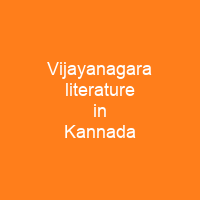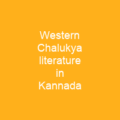Vijayanagara Literature in Kannada: A Golden Age of Literary Flourishing
Imagine a time when the vibrant hues of literature painted the canvas of Vijayanagara Empire, from the 14th to the 16th centuries. This era was not just about political power but also a flourishing of literary genius in Kannada. Was it the rich soil of the empire that nurtured such diverse and profound works?
The Socio-Religious Tapestry
Vijayanagara literature in Kannada was deeply intertwined with the socio-religious fabric of the time, focusing on Veerashaiva and Vaishnava faiths. Was it the devotion to these deities that inspired such a rich literary output?
The Rise of Veerashaiva Literature
During King Deva Raya II’s reign, Veerashaiva literature reached its zenith. The Tuluva dynasty rulers later brought about a high point in Vaishnava literature. How did these shifts in power influence the literary landscape?
The Influence of Jain Literature
Jain literature was on the wane due to competition from the resurgent Veerashaiva faith. The interaction between Kannada and Telugu literatures left lasting influences, with translations becoming popular. Was it this cross-pollination that enriched both traditions?
The Evolution of Court Literature
Court literature in Kannada underwent significant changes before the 12th century, dominated by Jain writers. However, Veerashaivas challenged this with vachana poetry, a stylised form of spoken language popular in folk genres. How did these shifts reflect broader societal changes?
The Diverse Voices
Vaishnava literature popularized musical forms that were more acceptable to the common man, while Veerashaiva writers focused on shorter local genres. Kumara Vyasa and Timmanna Kavi were well-known Brahmin commentators, while Purandara Dasa and Kanaka Dasa were famous Bhakti writers. Were these diverse voices a reflection of the empire’s multiculturalism?
The Philosophical Spread
The philosophy of Madhvacharya spread beyond its borders over the next two centuries through itinerant haridasas who preached devotion to God. The shatpadi metre was popular during this period, with poets like Chamarasa and Kumara Vyasa using it effectively. How did these philosophical ideas travel so far?
The Vijayanagara Period: A Time of Great Literary Output
The Vijayanagara period saw significant political changes, including competition between Vaishnava and Veerashaiva writers. Literary disputations were common, with organized processions held in honour of the classics written by poets from these faiths. The two groups of Vaishnava writers – Brahmin commentators and Bhakti poets – had little interaction with each other. Was this competition a driving force for literary innovation?
The Literary Giants
Vaishnava authors wrote treatments of Hindu epics and subjects from Hindu puranic traditions. Kumara Vyasa was an influential Vaishnava poet who successfully wielded the flexibility of the desi shatpadi metre. He wrote Gadugina Bharata in 1430, considered a master of medieval Kannada epic poetry. The title refers to Gadag (modern Gadag) where the author lived. Unlike Pampa, who adhered to a strictly Jain interpretation of the epic in his Vikramarjuna Vijaya (941), Kumara Vyasa portrayed characters with foibles and humor. This work marks the transition in Kannada literature from old to modern. Was this shift a reflection of changing societal values?
The Veerashaiva Literary School
The Veerashaiva literary school was challenged by the Srivaishnava intelligentsia, but radical writings by poets like Ratnakaravarni paved the way for unconventional literature. Maverick poets like Sarvajna and Sisunala Sherif wrote in the tripadi metre, influencing people with their humanistic values. How did these mavericks challenge the status quo?
The Ramayana Adaptations
Vaishnava authors wrote treatments of Hindu epics and subjects from Hindu puranic traditions. Kumara Vyasa was an influential Vaishnava poet who successfully wielded the flexibility of the desi shatpadi metre. He wrote Gadugina Bharata in 1430, considered a master of medieval Kannada epic poetry. The title refers to Gadag (modern Gadag) where the author lived. Unlike Pampa, who adhered to a strictly Jain interpretation of the epic in his Vikramarjuna Vijaya (941), Kumara Vyasa portrayed characters with foibles and humor. This work marks the transition in Kannada literature from old to modern. Was this shift a reflection of changing societal values?
The Secular Writings
Secular writings included accounts on urban life, grandeur of imperial and provincial courts, royal weddings and ceremonies. Works also referred to general town planning, fortifications and ordnance details at Vijayanagara and other important cities. Did these secular works provide a window into the daily lives of people?
The Literary Legacy
A wealth of literature dealt with subjects like astronomy, meteorology, veterinary science and medicine, astrology, grammar, philosophy, poetry, prosody, biography, history and lexicon, as well as dictionaries and encyclopedias. Was this diversity a reflection of the empire’s intellectual richness?
The Vaishnava Writings
Naraharitirtha’s compositions (14th century) and Haridasa Sahitya (‘Haridasa literature’) influenced by the Vaishnava school of Dvaita philosophy pioneered by Madhvacharya. Compositions in haridasa literature are sub-divided into four types: kirthane, suladi, ugabhoga and mundige. Kirthanes are devotional musical compositions with refrains based on raga and tala, celebrating the glory of god. Suladis are tala-based, while ugabhogas are melody-based and mundiges are in the form of riddles. How did these musical forms enrich religious devotion?
The Haridasa Tradition
Purandara Dasa (1484-1564) composed 475,000 songs in Kannada and Sanskrit languages, presenting the essence of Upanishads and Puranas. Kanaka Dasa (1509-1609) wrote important works such as Mohanatarangini and Nalacharita, narrating stories of Krishna and Nala. In the 17th century, an estimated 300 poets produced devotional songs in this genre, including Vijaya Dasa, Gopala Dasa, Jagannatha Dasa, Mahipathi Dasa, and others. Their songs inspired a form of religious performing art called Harikatha among Vaishnavas. How did these songs become an integral part of religious practice?
The Veerashaiva Writings
Veerashaiva writings include vachana poetry, developed in reaction to rigid caste-based Hindu society, which attained popularity among the under-privileged during the 12th century. The Veerashaivas wrote poetry during the Vijayanagara period, with influences from Muslim invasions and Hindu lore consolidation in the 14th century. Anthologists such as Kallumathada Prabhudeva and Channaviracharya collected Shaiva writings and vachana poems, adding commentaries to reveal their hidden meaning. How did these poems challenge societal norms?
The Mystical Literature
Mystic literature experienced a resurgence towards the beginning of the 15th century, with prominent mystics like Nijaguna Shivayogi composing devotional songs known as Kaivalya sahitya. His writings include a scientific encyclopedia called Vivekachintamani, which was translated into multiple languages. The post-Vijayanagara era saw the branching of the Kaivalya tradition into three ways, with followers of Nijaguna Shivayogi’s school and vachana poets like Muppina Sadakshari and Chidananda Avadhuta continuing to write. How did these mystical writings influence spiritual practices?
The Legacy
The Vijayanagara period was a golden age of literary output, with diverse voices contributing to the rich tapestry of Kannada literature. From Veerashaiva and Vaishnava faiths to secular topics, this era saw significant shifts in literary trends and philosophical ideas. Was it the vibrant cultural environment that fostered such creativity?

The legacy of Vijayanagara literature in Kannada continues to inspire and educate, offering a glimpse into the rich cultural heritage of this era. As we explore these works, we are reminded of the enduring power of literature to shape societies and beliefs.
You want to know more about Vijayanagara literature in Kannada?
This page is based on the article Vijayanagara literature in Kannada published in Wikipedia (retrieved on November 30, 2024) and was automatically summarized using artificial intelligence.







